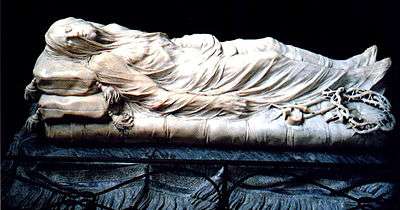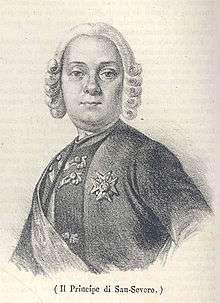Veiled Christ
Coordinates: 40°50′57″N 14°15′18″E / 40.84919°N 14.25488°E
| Italian: Cristo Velato | |
 | |
| Artist | Giuseppe Sammartino |
|---|---|
| Type | sculpture |
| Medium | Marble |
| Dimensions | 50 cm × 80 cm × 180 cm (20 in × 31 in × 71 in) |
| Location | Cappella Sansevero, Naples |
The Veiled Christ (Italian: Cristo velato) is a marble sculpture made by Giuseppe Sanmartino and preserved in the Cappella Sansevero, Naples.
The sculpture, produced in 1753, is considered one of the world's great sculptural masterpieces. Antonio Canova who once tried to acquire the work declared that he would willingly give up ten years of his own life to produce a similar masterpiece.[1]
History and description
Veiled Christ's production was originally assigned to the sculptor Antonio Corradini. However he died a short time later, having produced only a terracotta bozzetto (today displayed at the Museo nazionale di San Martino. The job thus passed to Giuseppe Sanmartino, who was charged with producing "a marble statue sculpted with the greatest realism, representing Our Lord Jesus Christ in death, covered by a transparent shroud carved from the same block of stone as the statue."[2]
Sanmartino produced a work with the dead Christ laid on a couch, covered by a veil which adheres perfectly to his form. The mastery of the Neapolitan sculptor lies in his successful depiction of the suffering that Christ had undergone during the crucifixion through the veil, under which signs of his pain can be seen on his face and body.
At the sculpture's feet, finally, the artist also carves the instruments of his torture: the crown of thorns, pliers, and some shackles.[2]
Legend of the veil
Over the centuries, the masterful depiction of the veil has acquired a legend, in which the original commissioner of the sculpture, the famous scientist and alchemist Raimondo di Sangro teaches the sculptor how to transform cloth into crystiline marble. For about three centuries, in fact, many visitors to the Cappella, amazed by the veiled sculpture, erroneously believed it to be the result of an alchemical "marblification" performed by the prince, who was meant to have laid a real veil on the sculpture and to have transformed this into marble over time by means of a chemical process.[3]
In reality, a close analysis leaves no doubt that the work was entirely produced in marble and this is also confirmed by some letters written at the time of its production. A receipt of payment to Sanmartino dated 16 December 1752, signed by the prince and preserved in the Historical archive of the Bank of Naples, states:[3]
Italian: E per me gli suddetti ducati cinquanta gli pagarete al Magnifico Giuseppe Sanmartino in conto della statua di Nostro Signore morto coperta da un velo ancor di marmo. English: And you will pay the aforementioned fifty ducats to the Magnificent Giuseppe Sanmartino on my behalf, for the statue of Our Lord in death covered by a veil also of marble.
In other letters, di Sangro also states that the veil was produced from the same block of stone as the statue.
See also
References
- ↑ "Cristo velato: il capolavoro" (in Italian). Museo della Cappella Sansevero.
- 1 2 "Cristo velato: la statua" (in Italian). Museo della Cappella Sansevero.
- 1 2 "Cristo velato: la leggenda del velo" (in Italian). Museo della Cappella Sansevero.
Bibliography
- Elio Catello, Giuseppe Sanmartino (1720-1793), Napoli, Electa, 2004.
